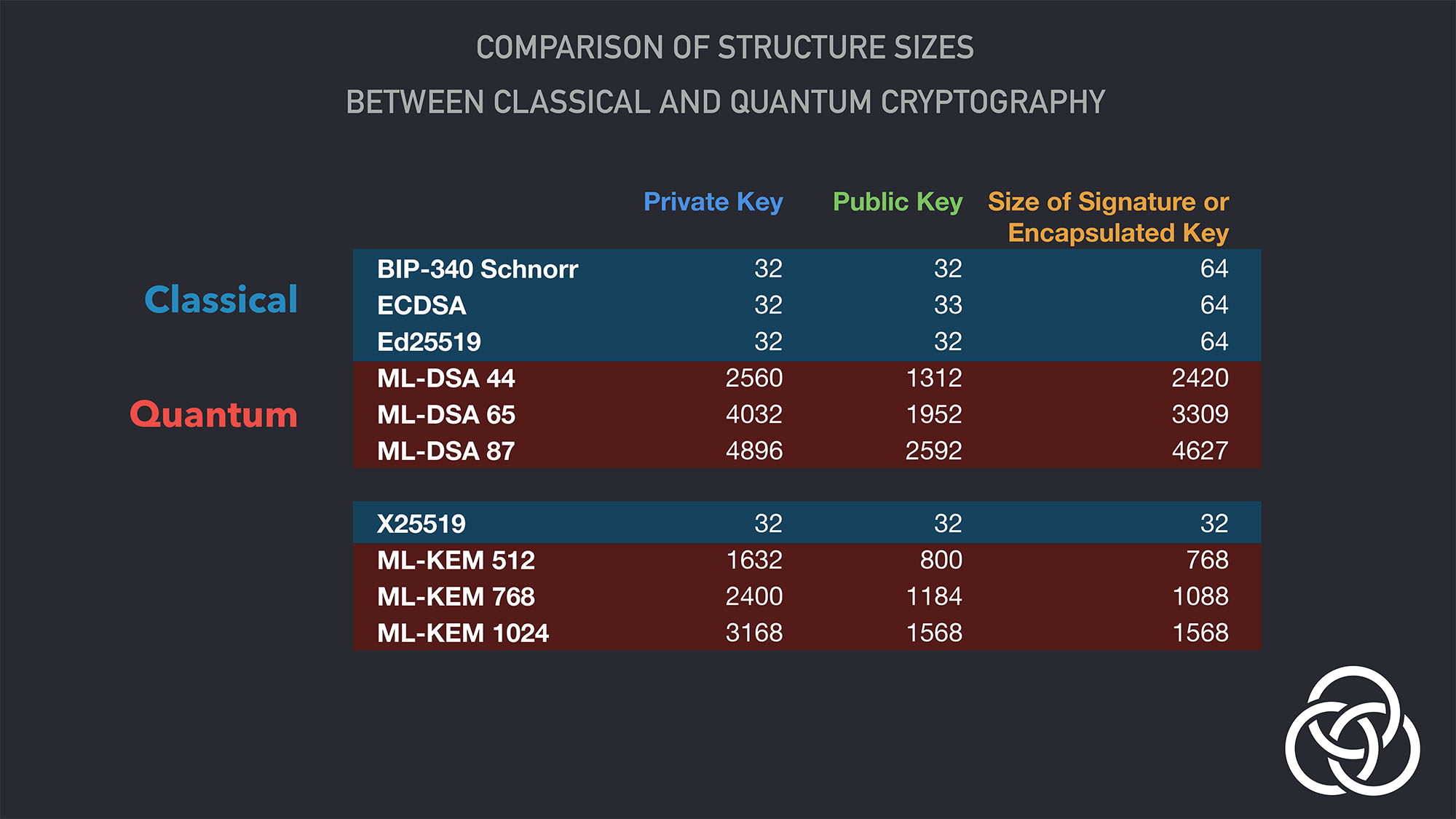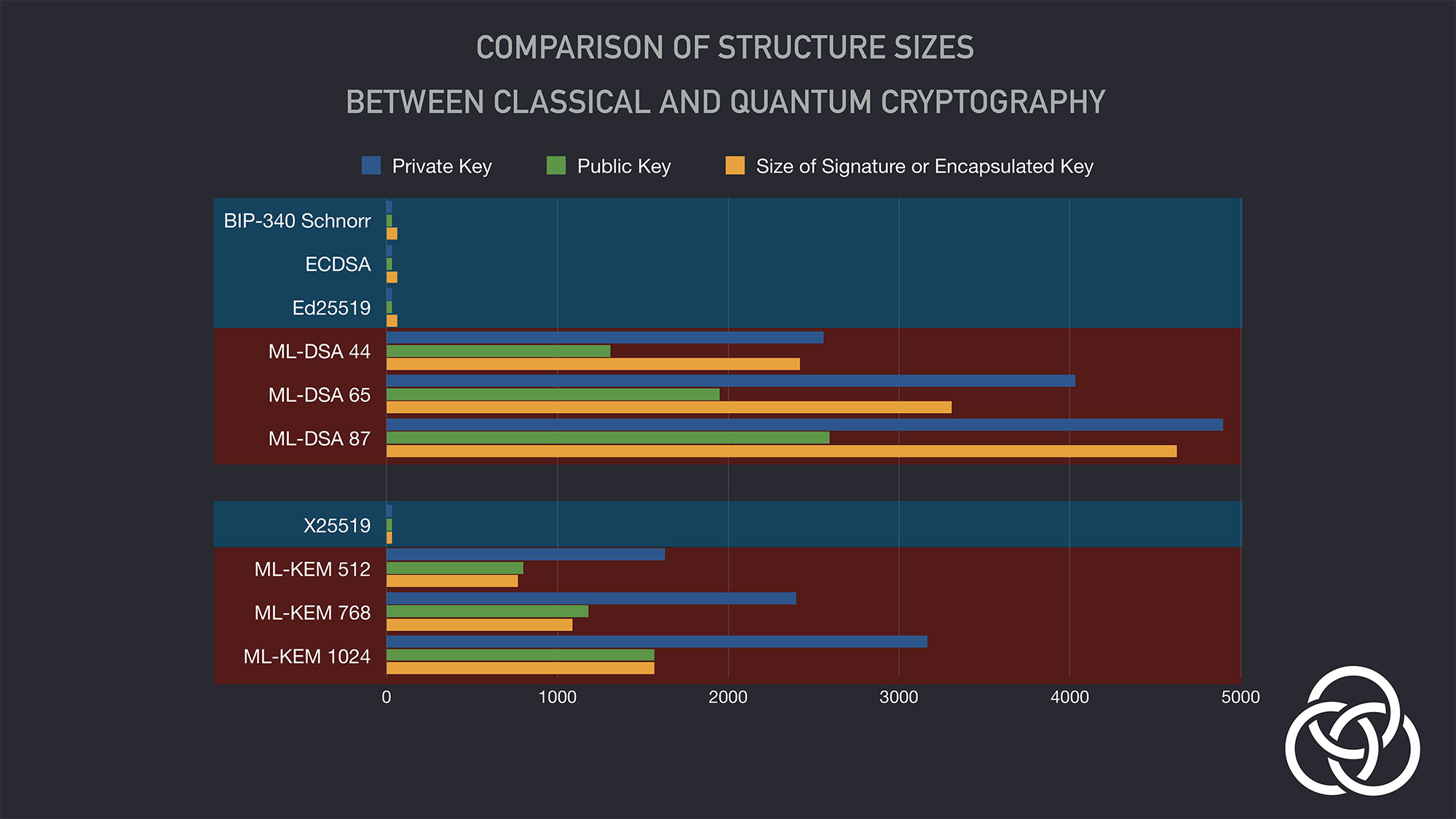The following is a rough summary of the March 5, 2025 Gordian Developers Meeting, focused on post-quantum cryptography.
Quantum Computing
Takes advantage of superposition & entanglement
- Can do some computing tasks quicker
- Discussion of RSA being broken as far back as 1994
Not everything is vulnerable, some cryptography just has its security level reduced
Quantum computers really exist,
- But Willow (Google) just has a few logical qubits
- And they’re just laboratory experiments
- Crypto attacks still likely 5-10 years off
- Nonetheless We need PQC to protect the future
Foundation & Quantum Link
QuantumLink is available in Passport Prime
- Airgapped Bitcoin wallets
- Personal Security Assistant
- with QuantumLink as Post Quantum Cryptography (PQC) communication
What’s the Problem?
Scanning QRs is main communication for airgapping and it can have user disadvantages
- Might need 100s of QR codes for large transactions!
- So MicroSD is the alternative, but that’s tough too!
- Doesn’t support up-to-date blockchain info
- Anti-Exfil would require more back and forth
Need more than QR+MicroSD!
QuantumLink is the Solution
Creates a secure local wireless communication method
- creating a better user experience
Uses out-of-band key exchange
- Create an encrypted tunnel
- everything is encrypted & signed
Works over Bluetooth, NFC, other transports
How Does It Work?
Key exchange: between Passport (hardware wallet and Envoy (mobile app) using QR
- Then Envoy returns using Bluetooth
Now have active secure tunnel
- every message has an encryption key
- which is encrypted with recipient’s public key
(Main MCU & Bluetooth MUCH are separated! Connected by SPI bus. All data between them is encrypted. so Bluetooth chip can’t intercept data!)
Advantages:
The Out-of-band key exchange secures communication
- All messages are encrypted + signed
- Bandwidth allows firmware updates!
- Can keep Prime up-to-date with blockchain info
What is Quantum Resistance?
Quantum computing vulnerability affects most classic crypto (RSA, ECDSA, Diffie-Huelman)
Quantum Resistance is crypto that isn’t vulnerable to quantum computers!
- lattice-based crypto
- hash-based signatures
- code-based crypto
- multivariate crypto
Lattice-based crypto is what Quantum uses
- ML-KEM used to encrypt a symmetric encryption key (ChaChaPoly, etc)
- ML-DSA for digital signatures
Quantum Link Under the Hood
- Passport shows static QR code with its Bluetooth device address
- Phone scans this and opens Envoy app
- Passport sees the connection and switches to an Animated QR code
- This is a UR code with a XID document and public keys for ML-KEM and ML-DSA
- Plus additional metadata
- Envoy saves data & builds response, which it sends over Bluetooth
- Because it can now encrypt & sign
- This creates encrypted tunnel
- Messages use Gordian Sealed Transport Protocol (GSTP)
- Request/Response using Envelopes
- expanded with Post-Quantum Computing
For more on these protocols, see Envelope, GSTP, and the Understanding Envelope video.
- Payload in messages is encrypted with ChaCha20Poly1305 Key
- ChaCha key encrypted with ML-KEM private key
- The public keys are looked up using XIDs
- Allowing connection with multiple devices!
QunatumLink payloads synchronize onboarding, sign Bitcoin transactions, update price & date, install firmware updates, and install new Passport Prime apps
Key Storage
Passport Prime stores keys with AES-256 encryption in secure element
Envoy stores keys with iOS Key Manager or Android Keystore
Currently, there’s a single public key exchange at time of initial pairing, but no formal key rotation
- User could perform pairing again
- Might have auto key rotation in future
Everything is open source! Blockchain Commons protocols are BSD-2-Clause-Plus, Passport Prime apps are GPL3+ or Affero GPL3+. QUantum Link will be documented! And third parties will be able to add messages.
For more on Passport Prime, see Foundation Devices.
PQC at Blockchain Commons
Why is Blockchain Commons advacing work on Post-Quantum Cryptography (PQC)?
Symmetric encryption using ChaCha20-Poly1305 is secure under Quantum Computing, but weakened.
Public-key crypto is totally broken!
- RSA, ECC, DH
- That is, if you have a sophisticated Quantum Computer (which doesn’t exist yet)
So symmetric crypto is OK with larger keys, but public-key crypto must be replaced
- That’s where ML-KEM & ML-DSA come in
ML-DSA
- Module Lattice Digital Signature Algorithm
- Non-deterministic
- Not linearly composable (no PQC DSA is!)
ML-KEM
- Module Lattice Key Encapsulation Mechanism
Blockchain Commons abstracts crypto use
- Not crypto-agile
- But crypto-agnostic
No SLH-DSA Yet
- Hash-based instead of lattice-based signatures
- Very large & somewhat redundant
- Would be easy to add due to abstraction
Because of challenges with large, slow quantum signatures
- Blockchain Commons uses a two-step process
- PQC for key exchange & rotation
- Classic crypto for ongoing usage


Available in bc-components in Blockchain Commons stack
- has primitives used by higher level things
- such as keypairs & encryption!
Signature schemes abstracted! SSH, ML-DSA, ed25519, ecdsa, and schnorr!
- Similarly encryption is abstracted: X25519 or ML-KEM
- Just change part of a line of code to change crypto scheme used!
ZeWIF Project
Blockchain Commons has long been supported by Bitcoin community, but wants to protect everyone doing self-sovereign digital wallets. We want everyone to use our “layer 0” specifications to help protect their wallet holders!
That includes Zcash, who came to Blockchain Commons to talk about how they were deprecating their software wallet, zcashd
- Allowing Blockchain Commons to create interchange format
This is important because
- we don’t want people to be locked into a single wallet
We want to encourage
- Cooperation
We want users to have
- Freedom
- Not to lose their funds
Gordian Principles
We want to support COMPATIBILITY and USER CHOICE
- on Bitcoin & elsewhere!
Uses Envelope, just like QuantumLink